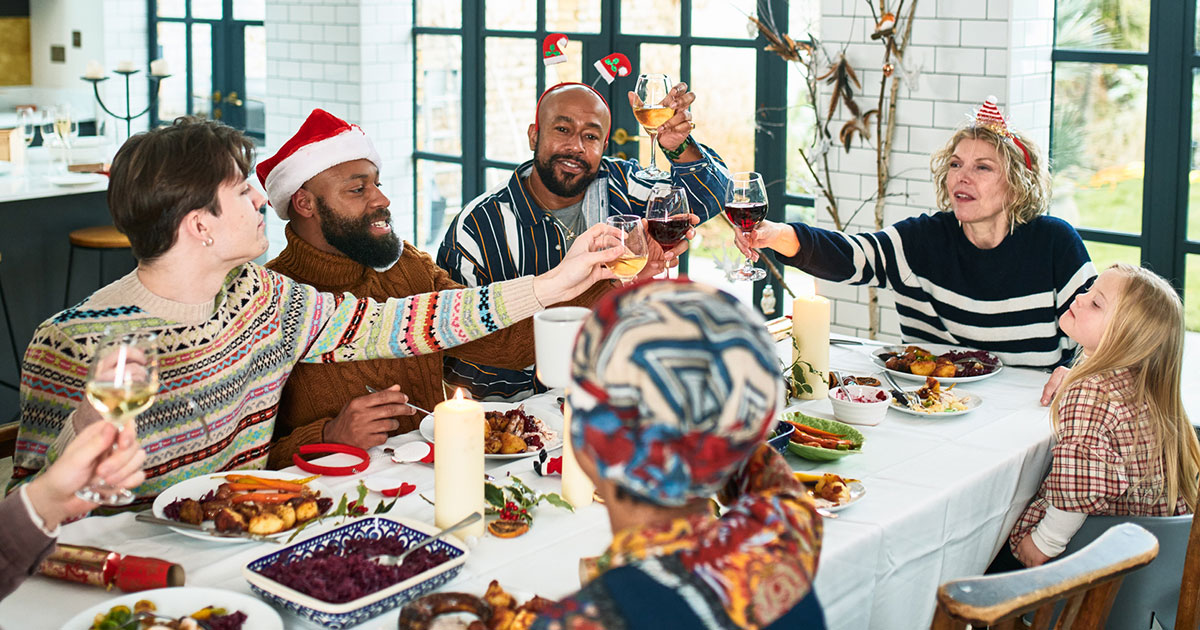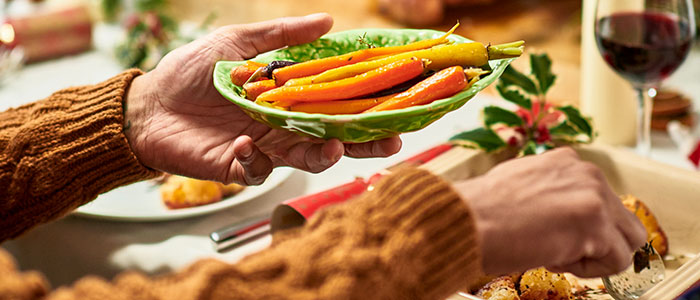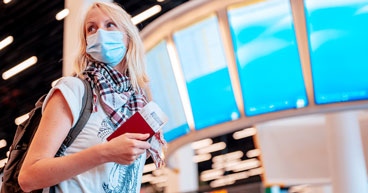
The holidays are all about good times, fun gatherings and food. And while cancer patients may easily embrace the joy of the season, traditional holiday foods may present challenges.
Cancer patients often have symptoms and side effects that may make it difficult to enjoy Thanksgiving dinner or a Christmas potluck. “With so many holiday celebrations centered around food, there’s an emotional stress for some patients, if they are having a hard time tolerating eating and they want to enjoy the holidays with their friends and family,” says Linda Hang, clinical dietitian at City of Hope® Cancer Center Duarte.
Even for those who are not having digestive issues, the holiday season brings with it the temptation to overindulge. Unfortunately, many traditional favorites tend to be high in fat, sugar and salt and may not be particularly healthy.
Eating healthy foods is especially important for cancer patients whether you’re currently in treatment or a cancer survivor. Healthy foods not only support your immune system, eating well before, during and after treatment may also help patients feel better, stay stronger, fight infection and maintain a healthy weight.
So, is it possible to indulge in savory turkey and stuffing, creamy mashed potatoes and rich pecan pie without adding unwanted pounds? Are there comfort foods cancer patients going through chemotherapy may enjoy without triggering side effects?
According to Carolyn Lammersfeld, Vice President of Integrative Oncology and Clinical Services at City of Hope Cancer Centers Atlanta, Chicago and Phoenix, the answer is yes—with some modifications.
“Try to focus on nourishing your body with healthy foods, while balancing the comfort that may come from enjoying some of your holiday favorites with family and friends,” she says.
In this article, we’ll offer tips on how to avoid overeating at the holiday table and make healthier versions of some seasonal foods and drinks. We’ll also provide ways patients undergoing cancer treatment may be able to enjoy holiday gatherings focused on food despite common side effects. Topics include:
- Healthy foods for cancer patients
- Dealing with treatment side effects
- Food tips for patients on chemotherapy
- Eat this, not that
- Drink this, not that: Holiday edition
If you’ve been diagnosed with cancer and are interested in a second opinion on your diagnosis and treatment plan, call us or chat online with a member of our team.
Healthy foods for cancer patients
It’s important for cancer patients to strike a balance between party foods, which tend to be high in salt and fat, and healthier fare, such as lean proteins, fruits and vegetables.
“A good way to balance what you eat is to follow the 80-20 rule, where 80 percent of the foods and beverages you consume are nutritious and 20 percent are a little more indulgent,” Lammersfeld says. “Of course, 85-15 or 90-10 is even healthier, but may not be realistic for everyone.” Lammersfeld offers these healthy suggestions for patients concerned about maintaining a healthy weight.
Don’t go to holiday events hungry. Before you go, eat something small, such as fresh fruit or vegetable sticks with nut butter or yogurt. This strategy helps maintain blood sugar levels and curb cravings.
Eat smaller portions. Use a salad plate, to encourage smaller portions. Fill most of your plate with plant-based foods.
Fiber first. Fill up on high-fiber foods first, such as salads and whole grains to help curb your appetite.
Think before you eat. Practice mindful eating, such as waiting 20 minutes before getting seconds.
Talk more, eat less. Mingle to reduce unconscious snacking.
Hydrating eases hunger. Sip on water to keep yourself feeling full so you don’t overeat.
Lammersfeld also offers the simple ingredient substitutions below for traditional high-fat recipes, including dips, bakery treats and cheeses. With just a few changes, you’ll enjoy healthier versions of your favorite foods by:
- Using two egg whites in place of one egg to reduce fat and cholesterol without losing the taste
- Using low-sodium, fat-free (or reduced-fat) chicken broth in mashed potatoes to add flavor and cut back on butter or margarine
- Substituting applesauce for oil, margarine or butter in muffins and breads
- Using fat-free (or reduced-fat) yogurt for dips, sauces and pie toppings
- Trying sliced almonds for a crunchy topping, instead of fried onion rings
- Using reduced-fat or low-fat cheeses, such as mozzarella, for salads and casseroles
- Substituting vegetables or fruit for dipping, in place of crackers and chips
- Substituting fruit or fruit cobblers for desserts in place of sweets that are high in sugar and low in nutrients
You may also want to try a few holiday recipe makeovers suggested by the Cancer Fighters® community. For a new taste twist on a festive favorite, consider oven-roasted turkey breast or grilled chicken with fresh herbs. For a fresh side dish, swap out mashed potatoes for mashed cauliflower with light sour cream to cut calories. For dessert, enjoy all the flavor and 75 percent less sugar with this recipe for not your traditional pecan pie.

Dealing with treatment side effects
If you’re a cancer patient experiencing treatment side effects, consider these ideas to make holiday gatherings focused on food more palatable.
Ask a dietitian. Many patients in active treatment have access to nutritional support. “If you are having specific issues, you can always ask a dietitian for tips,” says Erica Tepepa-Ponce, clinical dietitian at City of Hope Cancer Center Duarte. “Let’s say you’re having diarrhea or GI (gastrointestinal) issues. A dietitian may be able to help with what you need to avoid and what kinds of food you can eat.”
Eat smaller amounts more often. Taking in a small amount of food every few hours instead of eating three big meals may help calm your stomach. The smaller amount also makes it more manageable, if you don’t feel like eating.
Enjoy what you can, freeze what you can’t. Some favorite holiday foods may be stored in the freezer to enjoy later when you’re feeling better. Sugar cookies and sweet potato casserole are two examples of holiday foods that may be frozen for several weeks.
Bring your own dish. If you are uncertain about what’s being served at a holiday gathering, bring something you know you can eat and enjoy. “Plan ahead and bring something you know you can tolerate,” Hang says.
Focus on the people. Don’t shy away from gatherings because you can’t enjoy the food. Being social and spending time with loved ones is critical to your mental health.
“Patients can prepare themselves for these types of eating events or gatherings when perhaps they may not be able to tolerate a feast,” Hang says. “But they can prep themselves by eating what they can tolerate prior to these gatherings. And then during the social time, they can just enjoy the company of their friends or family.”
Food tips for patients on chemotherapy
If you’re experiencing any of the common side effects of chemotherapy below, consider these ideas offered by Lammersfeld. These are general suggestions, so make sure to follow any modified diet that your care team has recommended for you based on your type of cancer and/or treatment.
Loss of appetite
- Support your energy and help prevent weight loss by eating spreads and dips like hummus, nut butters and avocado or guacamole.
- Strong smells may hinder your appetite. Ask friends and family not to wear cologne and your host not to burn scented candles.
Nausea
- Stick with blander foods such as bread, potatoes, noodles, crackers, soups, vegetables and soft, tender meats that are not heavily sauced or seasoned.
- Ask your host to use olive or canola oil instead of butter or margarine.
- Ginger may help ease a queasy stomach, so consider bringing your own ginger tea, gum, chews or cookies.
Diarrhea
- Avoid caffeine, spicy foods and fatty, greasy or fried foods.
- Avoid foods with insoluble fiber. While this type of fiber promotes regularity, it may make diarrhea worse. Insoluble fiber is found in most raw vegetables and some whole grains, including whole wheat.
- Choose foods with soluble fiber, including barley, oats, sweet potatoes, citrus fruits, bananas, strawberries, beans, lentils and green beans, which are easier to digest.
- Stay well-hydrated by sipping on fluids between meals. Choose a sports drink or electrolyte beverage to help keep you hydrated, and your electrolytes balanced.
Sense of taste
- Before eating, rinse your mouth with water or a rinse made with water, baking soda and salt to help clear your palate.
- If you struggle with a metallic taste, eat with plastic utensils instead of silverware. And ask your host to cook foods in glass or ceramic pots and pans.
- Bring your favorite sauce and/or beverage to the party, so you can eat or wash down food with something you know you’ll enjoy.
Mouth sores
- Avoid citrus sauces and highly acidic foods like oranges, tomatoes, lemons or limes and spicy foods that may cause burning.
- Try soft foods and cooled-down soups that don’t require a lot of chewing.
- Keep your mouth moist and drink plenty of fluids.
- Try sucking on frozen fruits like grapes, melon, peach slices or ice chips, and use a lip moisturizer with vitamin E, which may help with healing.
- Bring a nutritional shake with you so if you can’t eat or tolerate a lot of the foods available at your holiday meal, you’re still able to get the calories and protein you need.
- Talk to your oncologist about specialized mouthwashes that may ease mouth sore pain and help you heal.
Patients who have experienced weight loss or are trying to recover from the side effects of cancer treatment are often encouraged to eat a healthy high-protein diet.
“Everything is about balance. But for most patients it's important to target protein and protein-rich foods,” Hang says. “Treatment can put a lot of stress on the body with a lot of metabolic stress. So, muscle preservation is very important. If they’re recovering from surgery, for instance, protein is highly emphasized.”
Eat this, not that
While it’s important to eat healthy foods, for some cancer patients just eating is important. Patients are encouraged to eat foods they can tolerate—in moderation—even if they may not be the healthiest choices. High fat foods may be a good choice for patients who have lost weight, but Tepepa-Ponce recommends patients look for healthy fats, such as avocados or olive oil.
“If a patient is losing quite a bit of weight and they're not tolerating most foods I would definitely recommend high-calorie, high-protein foods ,” she says. “Obviously, whenever possible, healthier fats instead of saturated fats are best. But if that's all they can eat and they want to get some extra, then ice cream and things like that would be completely fine.”
City of Hope registered dietitians have compiled some suggestions on holiday foods patients should enjoy and those to avoid.
Eat this: Shrimp cocktail, Swedish meatballs or chicken satay.
These are high in protein and low in fat. For example, 10 shrimps with cocktail sauce pack just 120 calories and less than 1 gram of fat.
Not that: Mixed nuts.
Almonds and cashews are healthy and packed with protein, fiber and healthy fat. The problem comes when you eat more than an appropriate portion. One cup of mixed nuts has more than 800 calories and 70 grams of fat. Either skip the nuts or count out 15-20 pieces on your plate so you have a reasonable portion (approximately 150 calories).
Eat this: Salsa or bruschetta.
These foods are low in calories. A quarter of a cup contains about 10 calories and zero grams of fat. They’re also usually made with tomatoes, which contain lycopene, an antioxidant that may aid in cancer prevention. Salsa is usually eaten with chips and bruschetta on toasted bread, so moderation is the key.
Not that: Spinach and artichoke dip. This creamy dip weighs in at a whopping 300 calories and 19 grams of fat per portion. It’s usually eaten with bread or chips, which may easily add on another 150-200 calories.
Eat this: Veggies with hummus.
Veggies are packed with antioxidants, and hummus only has about 50 calories and three grams of fat per serving, making it a nutritious choice.
Not that: Veggies with ranch or blue cheese dressing.
Dips like these deliver a devastating 150 calories and 16 grams of fat per two tablespoons. You may consume 750 calories of dressing alone without realizing it.
Drink this, not that: Holiday edition
Cancer patients undergoing treatment should talk with their doctors before partaking in any beverages with alcohol.
“Alcohol could interact with medications when you’re on chemo, so typically it's not something we would recommend,” Hang says. “If they are off treatment and there's no issue with drug interaction, we usually will suggest one serving. Moderation for celebration should be fine.”
One harmful side effect of drinking alcohol is the risk of becoming dehydrated. Alcohol is a diuretic, which means it causes the body to remove fluids from the blood at a much faster rate than non-alcoholic beverages. If you don’t drink enough water with alcohol, you may become dehydrated quickly.
Even mild dehydration may cause symptoms such as fatigue, headaches, dry skin and constipation. If you become dehydrated, your cancer treatment may have to be delayed or your treatment dose adjusted, and patients with severe dehydration may have to be hospitalized.
Drink This: Mocktails
Sparkling water, caffeine-free herbal or spiced teas and a splash of fruit juice make for delicious alcohol-free concoctions.
Not That: Creamy coffee drinks, eggnog and alcoholic beverages.
If your holiday isn’t the same without a peppermint mocha, make sure it’s the smallest size and limit it to one serving: The 8-ounce version has 240 calories and 28 grams of sugar per cup.
If you’ve been diagnosed with cancer and are interested in a second opinion on your diagnosis and treatment plan, call us or chat online with a member of our team.


